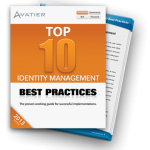Any business user can be a “Man of Steel” and manage their own accounts to streamline operations, lower costs and better service. When you automate your IT service catalog user provisioning software, you’re able to grant your users the capability to safeguard your security through permissions specific to each user.
Based on this premise, our IT Store software solution allows users to “shop” for the access, assets, tools and group memberships that they need to do their jobs. With the IT Store, the approval process is automated, and your IT staff is able to view and administer everything in a centralized place.
What are the advantages to this approach and what should you look for in an IT service catalog with self-service user provisioning?
- Automated user provisioning streamlines operations and saves time and money. Once protocols are in place and individual permissions are established, your user provisioning software takes care of the rest. Users are empowered and accountable with the access they need to handle a host of IT management issues themselves, thereby, freeing up your IT staff for other important projects. This improves workflow and operational efficiency across an organization.
- User provisioning permissions should extend to the IT service catalog. To control spending, look for asset budgeting tools and controls. Your staff should be able to keep a running balance against what they have budgeted and spent so that accountability is inclusive and all parties in your organization are on the same page.
- It’s so much easier for everyone when users can execute their own authorized requests. Self-service administration empowers users to submit requests on their own, while providing automated safeguards and security to ensure that you have full visibility into user accounts, approvals, privileges and budgets.
- To make sure that you’re always up-to-speed on what’s happening with user provisioning requests, look for push notification capabilities. These capabilities ensure that you receive your cyber security alerts in real-time and that you can proactively monitor your network for added, disabled, removed and out of compliance accounts.
- When it’s time to deactivate an account, make sure that account termination protocols automatically remove access across all your systems and groups. Automatic de-provisioning ensures that terminated employees can’t continue to access your network, systems, and groups once you revoke their privileges.
- To make it simple and easy for your users to manage their own accounts within prescribed protocols, select a solution with a user-friendly dynamic UI and an amazing user experience. A dynamic UI provides all users with a customized view into their IT store based on a predefined attributes that facilitate self-service so that users actually access the user provisioning system and manage their own accounts as easy as shopping online.
- Your solution should also include shortcuts and favorites to facilitate accessing internal web sites as well as external systems and cloud computing services. The shortcut feature should place these entities on the start-up page.
If the IT service catalog user provisioning software solution you select contains these features, you’ll be leaping problems in a single bound and automating user provisioning to empower your staff with self-service identity management administrative capabilities. In turn, you will improve your efficiency, service quality and give them the power to offer (almost super human) identity and access management information security strength.
Watch Ryan Ward, Chief Innovation Officer at Avatier, describe how to return identity and access management to the business user with Avatier’s Identity Access Management software.
 Get a Free Copy of the Top 10 Identity Management Best Practices Workbook
Get a Free Copy of the Top 10 Identity Management Best Practices Workbook
Begin your identity management initiative by following what corporate compliance experts recommend for the workflow automation of businesses processes, self-service administration and IT operations.




